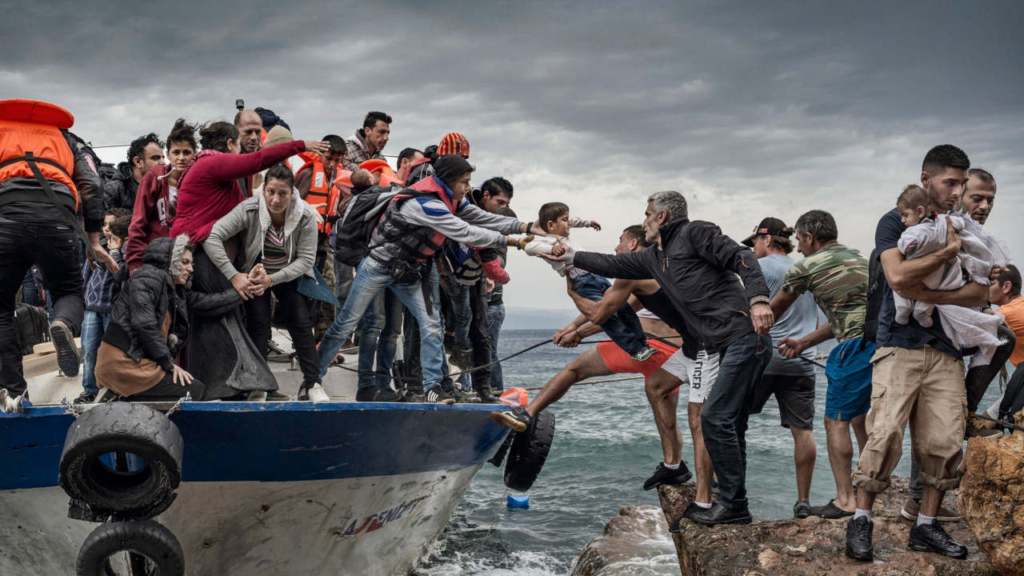Casebook Info
Ruling in favor of a Nigerian refugee, the Italian Supreme Court set out a pathway for protecting peoples displaced by climate change. The Supreme Court held that when considering a request for international protection, courts must consider whether or not an immigrant’s right to (dignified) life is threatened by environmental degradation in their country of origin. Notably, the court explicitly recognized that this environmental degradation may be caused by climate change.
- Year Filed 2019
- Year of Most Recent Ruling 2021
- Year of Final Ruling 2021
- Jurisdiction Italy
- Court Name Supreme Court of Cassation
- Primary Focus Migration
- Ruling On Merits
- Plaintiff(s) Refugee from the Niger Delta
- Respondent(s) Refugee from the Niger Delta
- Outcome N/A
- Organizational leader of the litigation N/A
- Link to the decision/ruling
Background
Seeking Refuge from Environmental Degradation
Over the past decade, millions of people fleeing persecution, conflict, and economic deprivation have traveled to Europe. Many of these people traveled to Italy by making the dangerous crossing from North Africa across the Mediterranean Sea. In reaction, the Italian government has become increasingly anti-immigration, taking prevent immigrant arrivals and restrict asylum laws. Yet thousands of people continue to seek asylum in Italy.
One of these refugees* was IL, a Nigerian man from the Niger Delta region. The Niger Delta, an oil-rich area, has suffered severe environmental degradation from decades of oil pollution and gas flaring. U.N. Special Rapporteur David Boyd described the region as one of the world’s many “sacrifice zones,” where residents experience severe health problems from the pollution (A/HRC/49/53, ¶31). The region has also experienced ongoing conflict, including fighting between paramilitary groups. The average life expectancy for Delta residents is only 40 years, a whopping 15 years below the national average. (Boyd, ¶31).
Fearing return to Nigeria, IL applied for asylum in Italy. His application was initially rejected by the Ancona Territorial Commission for the Recognition of International Protection. On appeal, the Court of Appeal of Ancona affirmed the Commission’s decision. The court found that there was serious environmental degradation and conflicts over resources in the Niger Delta region, however the court concluded that this situation did not pose a risk of ‘serious harm’ (Fazzini, p. 204).
So, IL appealed his case to the Supreme Court of Cassation, Italy’s highest court. He argued that the lower courts had committed a procedural error by failing to assess the facts of the environmental crisis in the Niger Delta. He further argued that the courts had substantively erred by not granting him humanitarian protection** based on the environmental crisis, thereby violating Italian immigration law.
Supreme Court: Environmental Degradation May Be Grounds For Protection
In a ground-breaking decision, the Supreme Court reversed the lower courts and articulated a human rights basis for protecting peoples displaced by environmental degradation and climate change.
The court started by acknowledging the “serious environmental instability” in the Niger Delta due to “indiscriminate exploitation . . . by oil companies” and ethnic-political conflicts (p. 2). Recounting the facts of the case, the Supreme Court noted that oil spills have contaminated large areas of the Delta and that residents live in “considerable poverty,” receiving no benefit from the oil exploitation.
The court then turned its discussion to the U.N. Human Rights Committee’s (HRC) recent decision in Teitiota v. New Zealand. In Teitiota, the Committee declared that a country may not deport someone to a country where climate change or environmental degradation pose a significant threat to their right to life, which includes a right to a life with dignity. Accordingly, the Supreme Court reasoned, “States are bound to ensure that individuals have living conditions that make it possible to fully express the right to life, in its broad form, even regardless of the existence of a present danger to survival.” (p. 3). A government fails to protect the right to life when it “cannot, or does not want to, ensure the conditions necessary to guarantee everyone access to essential natural resources, such as arable land and drinking water” (p. 5). By extension, a government violates the right to life if it deports an individual to a country that cannot or will not protect the individual’s access to essential natural resources.
Following this reasoning, the Supreme Court held that courts must consider “the [particular] risk for the right to life and for the right to a dignified existence resulting from environmental degradation, climate change or unsustainable development of the area” when assessing the danger an applicant faces in their country of origin (Ordinance no. 5022/2021, p. 5-6). To do this, the court must consider whether the socio-environmental conditions— including environmental or climatic degradation— in an asylum seeker’s country of origin fall below the minimum threshold for “decent living conditions” (p. 7). This requires looking beyond the existence of armed conflict, since environmental degradation can equally impair dignified living conditions.
Thus, the Supreme Court concluded that the trial court erred by failing to properly assess IL’s ability to live a life of dignity in the Niger Delta, despite finding that the Delta was experiencing environmental disaster. The Supreme Court remanded IL’s case to the Court of Appeal, instructing the court assess whether the conditions in the Delta meet the minimum threshold for a dignified life.
*Under the ‘declaratory theory’ of refugee status, a person is a refugee if they satisfy the legal definition of a refugee even if they have not been recognized by a government or institution. According to this view, which has been endorsed by the U.N. High Commissioner for Refugees (UNHCR), a person is a refugee even if they are formally classified as an “asylum-seeker” (i.e., someone who is requesting, but has not been granted, international protection).
**Humanitarian protection covers individuals who are not eligible for refugee status but who should be deported for humanitarian reasons. In 2018, the Italian legislature seriously limited this form of protection.
- ~40 million liters The amount of oil spilled across the Niger Delta each year (Rise for Bayelsa campaign).
- 80% The percentage of Delta residents who report chest pain, a symptom of oil pollution (Nriagu et al., 2016).
- 62,255 People applied for asylum in Italy between January and June 2023 (Statista)
Strategies
Applying a developed body of law in the context of climate change

The Supreme Court’s decision built on a series of recent decisions that clarified the scope of humanitarian protection in Italy. In 2018, the Supreme Court held that conditions of “radical impoverishment” in a “very serious political-economic situation” could fall below the minimum threshold for a dignified life (Ordinance no. 4555/2018, p. 9). The court noted that such a serious situation could be brought on by drought or famine. The Supreme Court subsequently noted in 2020 that environmental disasters, such as floods, can serve as grounds for humanitarian protection (Ordinance no. 2563/2020). These decisions laid the foundation for the court’s decision in this case.
In this way, the court progressively recognized that environmental conditions, including climate change, fall within the scope of humanitarian protection law. While the court’s ruling requires courts to consider the effects of climate change, IL’s situation did not require this consideration. The environmental disaster in the Niger Delta has not been caused by climate change, at least not in its entirety. By referencing climate change in a case about environmental degradation, the Supreme Court established precedent for peoples displaced by climate change. In future cases, the court may directly apply the law of humanitarian protection to conditions created by climate change.
Takeaways
Decisions by international bodies may influence domestic courts on climate change.
The court’s reliance on Teitiota v. New Zealand shows how international human rights bodies may influence domestic climate law. In Teitiota, the U.N. Human Rights Committee (HRC) broke new ground by recognizing that the right to life may require countries to protect people displaced by climate change. The HRC’s judgement was non-binding, but it established a basis for the Italian Supreme Court’s reasoning. In this way, the Teitiota decision gave legitimacy to the Supreme Court’s reasoning, and the Supreme Court gave legitimacy to the Teitiota decision.
Peoples displaced by climate change may be protected from deportation under the right to life.
The Supreme Court’s decision further affirms and develops the reasoning first articulated in Teitiota. It reflects an emerging view that countries have human rights obligations to protect climate migrants under the International Covenant on Civil and Political Rights. This is an important development, since the Refugee Convention does not protect those fleeing intolerable or unlivable environmental conditions. Fazzini also notes that the court’s decision could be read as applying a lower burden of proof than the HRC applied in Teitiota (p. 207). According to Fazzini, the Supreme Court seemed to indicate that an applicant may only have to prove the risk from general environmental conditions, rather than the individualized risk they face from these conditions.
Climate refugees may be protected by other human rights in addition to the right to life.
A key feature of the court’s reasoning (and the reasoning in Teitiota) is that an immigrant receiving country violates the right to life if it deports someone to a country that violates the right to life. In other words, a receiving country’s human rights obligations extend to would-be violations in other countries. While the Supreme Court and HRC have only applied this reasoning to the right to life, this reasoning could also apply to other fundamental rights. For example, a government might similarly be prohibited from deporting someone to a country where their rights to water, food, health, family life, or property are threatened by climate change. This reasoning could even be extended to the recently recognized right to a healthy environment.
Impacts
This is the first case in Italy that “deals directly and explicitly with climate change and the ensuing [human rights] obligations” (Vona, p. 148). The case could thus “pave the way for a first wave of rights-based climate cases before Italian courts,” particularly cases focused on climate refugee rights (Ibid.). The case provides a basis for other environmental migrants to argue that they should be protected from dangerous environmental conditions in their countries of origin.
In doing so, the Supreme Court’s decision also created potential for an expansion of the non-refoulement principle (Vona, p. 148; Fazzini, p. 207). Understood broadly, the non-refoulement principle protects individuals from human rights violations in their country of origin, even if those violations do not form the basis for protection under the Refugee Convention. As discussed above, this reasoning could justify international protection based on a variety of rights. At a minimum, the court’s decision establishes an obligation to protect environmental migrants from violations of the right to a dignified life.

